Wayne Elmo Mitchell

- Date of Birth: June 24, 1920
- Date of Death: October 7, 1943
- Hometown: Duchesne, Utah
- Place of Death: Wake Island
- Cemetery: Section G, Grave 68. National Memorial Cemetery of the Pacific, Honolulu, Hawaiʻi
Mentored by Ms. Aliyah Bacca
Salt Lake Center for Science Education
2022/2023
Early Life
Wayne Elmo Mitchell was born in Hayden, Utah, on June 24, 1920. He was the son of Arzy Homer Mitchell and Fern Hacking Mitchell and the brother of Trueman A. Mitchell, Loren H. Mitchell, Alfreda M. Hayden, and Howard H. Mitchell. Growing up, Wayne worked with his father on their farm.
After Wayne graduated from Duchesne High School, he first attended Brigham Young University and then Utah State Agricultural School. He and his family were active members of the Church of Jesus Christ of Latter-Day Saints.

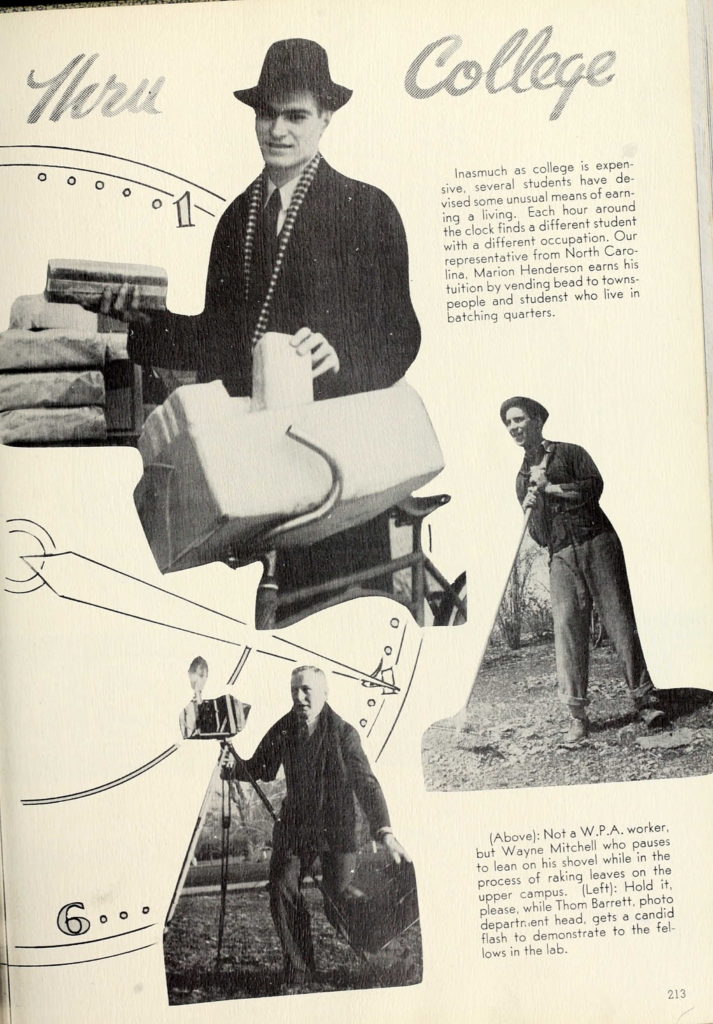
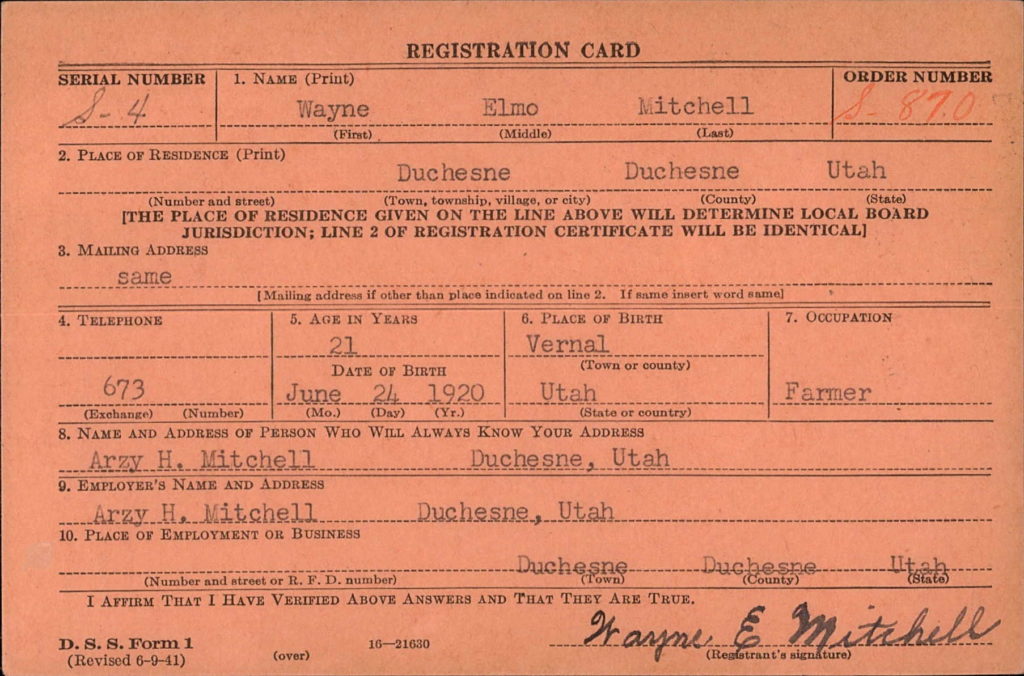
Homefront
Utah during the war played an important role in our country’s efforts. The state’s inland location and terrain made it perfect for training. There were 14 military installations built in Utah during the war.
Wayne’s hometown of Duchesne had oil and natural gas extraction industries and was surrounded by vast farmlands. The Duchesne area was the site for mining vital minerals such as coal, iron, dolomite, limestone, alunite, and copper for the war effort. The bordering counties of Uintah and Wasatch provided plentiful water to Mitchell’s home county of Duchesne, making it a rich and productive agricultural area. Women, men, and children all worked on conserving food supplies while increasing the area’s agricultural production. As more men left for the war, women in Duchesne, as in other communities, took on new roles.
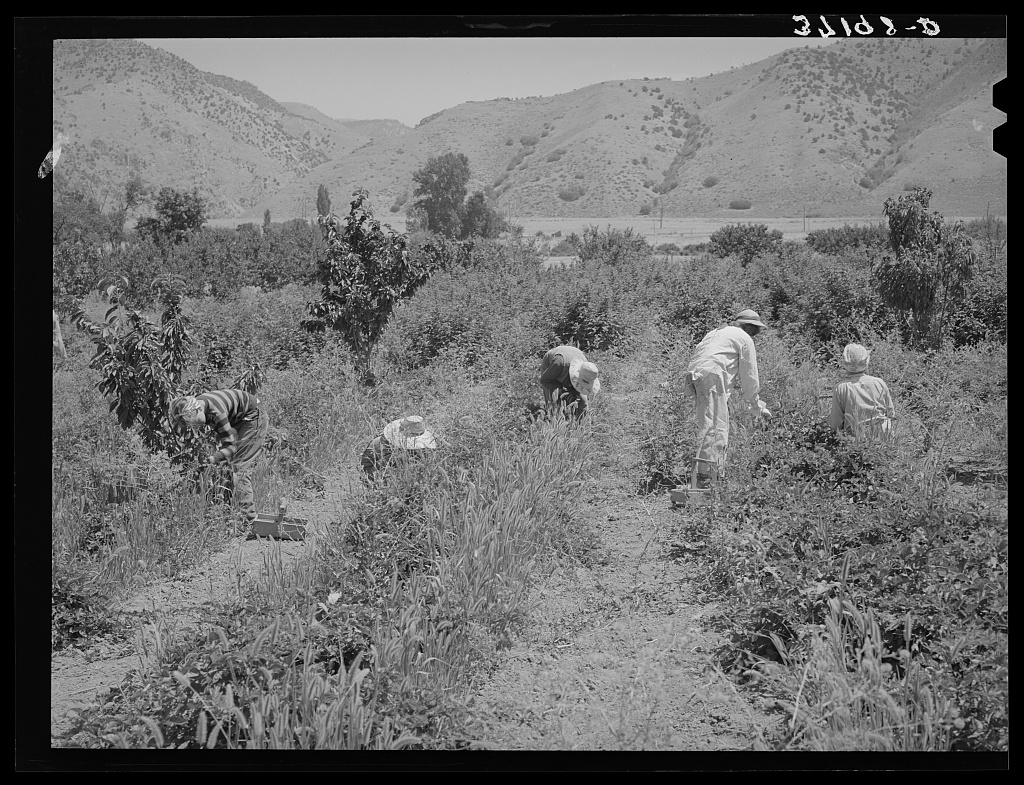
Military Experience
Civilian engineering firms and employees who built airfields, bunkers, and defenses across the many islands controlled by the United States were vital to the American preparation for entry into World War II. Wayne Mitchell, along with his brother, Howard, answered the call to help the United States get ready for war.
In early October 1941, Wayne took a job with the Morrison-Knudsen Company. He departed from San Francisco, California aboard the SS Monterey, on October 14, 1941 and arrive in Honolulu, Hawai’i a week later. He was following his older brother, Howard, who took this journey in June 1941. The company assigned him to work on the Pacific Naval Base on EnenKio, also known as Wake Island. He arrived at EnenKio on October 20, 1941. The Morrison-Knudsen Company was contracted to build a naval air base and other defense projects on the United States military installations on the island.
On December 8, 1941, the Japanese attacked Hickman Field at Pearl Harbor in Hawai’i and EnenKio, resulting in many destroyed resources, killing and injuring many soldiers and civilians.
From December 9 to 22, Japanese forces bombed and attacked EnenKio to gain new territory in the Pacific. Wayne took part in the defense of EnenKio until its fall on December 23, 1941. When it fell, 1,603 men were captured. Of those, 1,150 were civilian contractors who worked for Morrison-Knudsen Company. Two of these were Wayne Mitchell and his brother, Howard. Howard, Wayne, and the other Prisoners of War on EnenKio experienced unimaginable torture, horrific living conditions, and forced labor.
In February 1942, the United States forces attacked and periodically bombed EnenKio. In October 1943, an American air raid launched from the USS Yorktown hit the island. Japanese Rear Admiral Shigematsu Sakaibara, fearful of an impending invasion, decided to execute the Prisoners of War.
On October 7, 1943, Japanese forces executed Wayne Mitchell and his brother, Howard. One man escaped, famously carving “98 US PW 5-10-43” on a large coral rock. The unknown American was recaptured and beheaded by Rear Admiral Sakaibara.
Wayne and Howard’s parents were informed about their deaths on Friday, October 10, 1943. In 1945, the United States reclaimed EnenKio. The large mass grave meant that Wayne and Howard’s remains could not be identified when they were returned to Honolulu after the war. These civilians were interred in the National Memorial Cemetery of the Pacific in 1953. A memorial on EnenKio was erected to these brave civilians who were executed by Japanese forces.
After the war, Rear Admiral Sakaibara was convicted of war crimes and hanged in Guam on June 19, 1947.


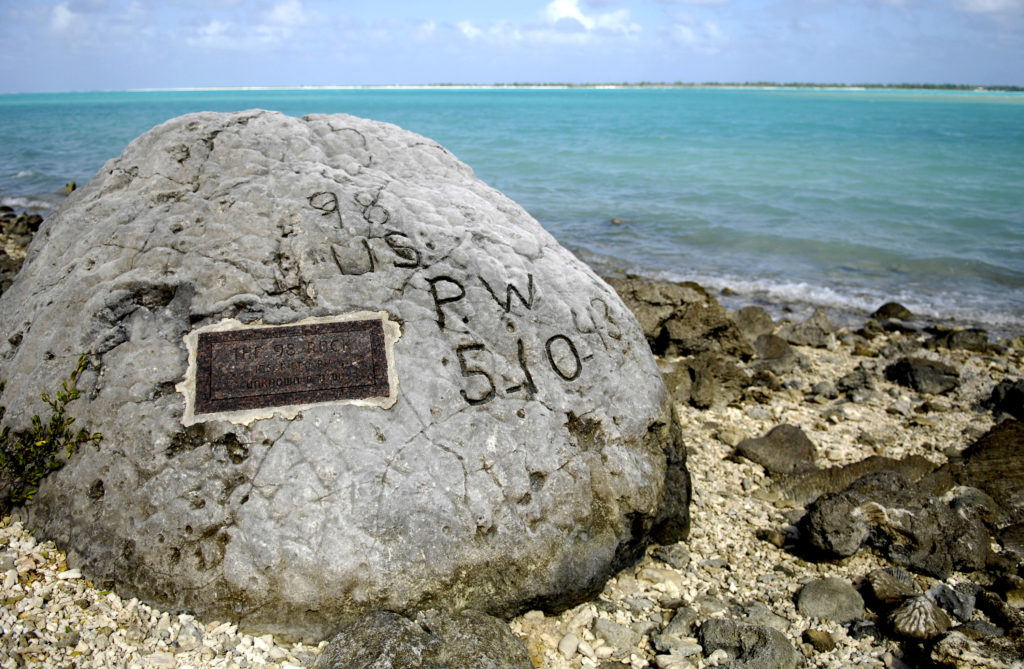
Eulogy
In October 1941, as the United States prepared for possible war, Wayne Elmo Mitchell was employed with the Morrison-Knudsen Company to help build defenses on American controlled Pacific islands. The company assigned him to work on the Pacific Naval Base on EnenKio, also known as Wake Island. He arrived at EnenKio on October 20, 1941. Wayne was contracted to help build a naval air base as well as other United States military defense projects on the island.
On December 8, 1941, the Japanese attacked Hickman Field at Pearl Harbor in Hawai’i as well as EnenKio. The attack killed and injured many soldiers and civilians. From December 9 to 22, Japanese forces bombed and continued their attack on EnenKio hoping to gain new territory. Wayne Mitchell took part in the defense of EnenKio until its fall on December 23, 1941. Two of the men captured by the Japanese forces were Wayne Mitchell and his brother, Howard. Wayne and the other Prisoners of War on Enen Kio experienced unimaginable torture, horrific living conditions, and forced labor.
In February 1942, the United States forces began to periodically attack and bomb the island. In October 1943, Japanese Admiral Shigematsu Sakaibara, fearing an American invasion, executed 98 civilians. On October 7, 1943, Wayne was executed alongside his brother, Howard, at the hands of the Japanese. His parents were informed about his and his brother’s deaths on Friday, October 10, 1943. It wasn’t until 1945 that the United States reclaimed EnenKio. Wayne and his brother’s bodies were never identified. These civilian soldiers were interred in the National Memorial Cemetery of the Pacific in 1953.
Wayne was a well-educated and faithful man who showed immense bravery through his service on EnenKio. Thank you for your service. Rest in love, Wayne Elmo Mitchell.

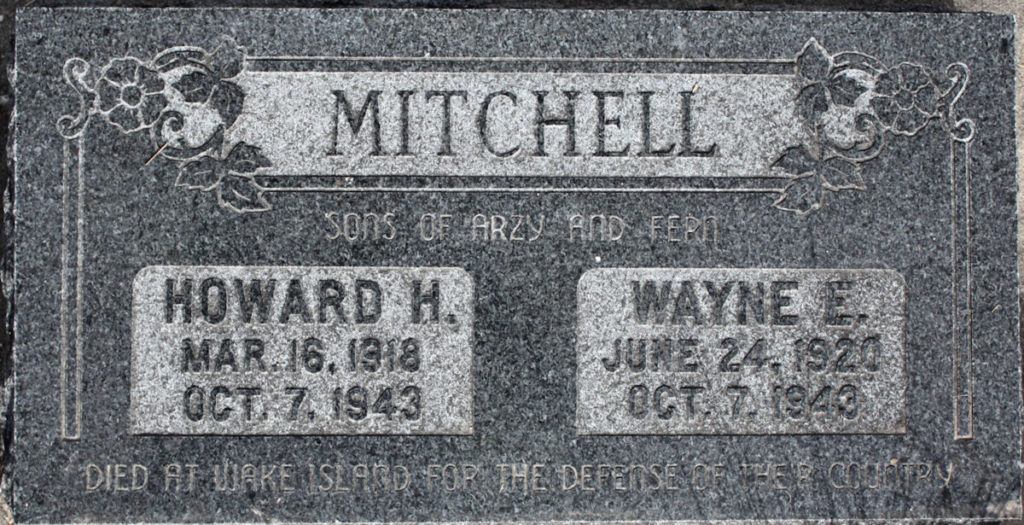
Reflection
I have learned much about World War II history, this country, and myself through this program. This experience has helped me gain a deeper and fuller understanding of World War II in the Pacific and its impacts. Unlike much of the history I had heard, I learned that the United States was preparing for an attack from the Japanese forces. However, the insight people gave to the United States government to prepare for the attack was ignored. This truth gave me more understanding into what our country was doing. The narrative of being defenseless and taken off guard by the Pearl Harbor attack was not the complete truth. Most of the history that is being told is not the whole and complete truth. I have learned to ask questions about history and seek different perspectives.
I have also gained a better understanding of humans that lived, fought, and who were victims of war and those who made decisions about war. Learning about the Japanese experience showed me that the narrative of them being the “villains” was not completely true. In American history, propaganda often painted our opposition as non-human. For example, kamikaze pilots were men who were dedicated to fight for their country just like the soldiers in the United States military. Being able to learn about the Japanese American experience showed me a new perspective on our country. No one deserved to go through oppression and be imprisoned simply due to their race. It is not right that Japanese Americans had to prove themselves in order to live in a country that was their home.
This experience has helped me learn many perspectives about our country’s history, the good and bad. I will continue to study all sides of a story so that I can be considerate of an individual’s experiences. This program has taught me that the way you get closer to gaining truth and insight is to question everything. By having this new knowledge, I can help others have a fuller understanding of World War II and give them a perspective of my Silent Hero, Wayne Elmo Mitchell.
Bibliography
Aerial view of Wake Island. Photograph. May 25, 1941. National Archives and Records Administration (80-G-451195). https://www.history.navy.mil/content/history/nhhc/our-collections/photography/numerical-list-of-images/nhhc-series/nh-series/80-G-451000/80-G-451195.html.
“Brothers Perish on Wake Island.” Deseret News [Salt Lake City, Utah], January 11, 1946. Newspapers.com (595315494).
Cuomo, Technical Sergeant Shane A. 98 Rock, Wake Island. Photograph. January 12, 2008. U.S. Air Force (080112-F-2034C-203.JPG). https://www.af.mil/News/Photos/igphoto/2000412578/.
“Duschene County Youths on Wake Island in Pacific.” The Roosevelt Standard [Roosevelt, Utah], December 11, 1941. Newspapers.com (288212444).
Lee, Russell. Young People from Logan picking berries . . . Photograph. August 1940. Library of Congress (2017787356). https://www.loc.gov/item/2017787356.
“Maw Pays Tribute to War Heroes.” Vernal Express [Vernal, Utah], February 14, 1946. Newspapers.com (290172616).
“Navy Reports 3 Civilians From Utah Dead on Wake.” The Salt Lake Tribune [Salt Lake City, Utah], January 12, 1946. Digital image. https://ancestryclasroom.com.
“New Youth Wait Call to Nation’s Service.” The Uintah Basin Standard [Roosevelt, Utah], August 22, 1941. Newspapers.com (545473237).
“Obituary for Wayne Elmo Mitchell.” Vernal Express [Vernal, Utah]. https://ancestryclasroom.com.
Utah. Duschene County. 1930 U.S. Federal Census. Digital images. https://ancestryclasroom.com.
Utah. Duschene County. 1940 U.S. Federal Census. Digital images. https://ancestryclasroom.com.
“War Crimes: Retribution.” TIME, January 7, 1946. https://content.time.com/time/subscriber/article/0,33009,797715,00.html.
Wayne Elmo Mitchell. Honolulu, Hawaii, U.S., Arriving and Departing Passenger and Crew Lists, 1900-1959. Digital image. https://ancestryclasroom.com.
Wayne Elmo Mitchell. National Cemetery Interment Control Form. Digital image. https://ancestryclasroom.com.
Wayne Elmo Mitchell. Utah, U.S., Birth Registers, 1892-1944. Digital image. https://ancestryclasroom.com.
Wayne Elmo Mitchell. Utah, U.S., Military Records, 1861-1970. Digital image. https://ancestryclasroom.com.
Wayne Elmo Mitchell. World War II Draft Cards Young Men, 1940-1947. Digital image. https://ancestryclasroom.com.
Secondary Sources
Barton, John D. “The War Effort At Home.” National Agriculture in the Classroom. Accessed October 24, 2023. https://cdn.agclassroom.org/ut/lessons/cc/war_effort_at_home_article.pdf.
“Duchesne County History.” Duschene County. Accessed October 24, 2023. https://duchesne.utah.gov/gov/about-the-county/history/.
Launius, Roger D. “World War II in Utah.” Utah History Encyclopedia. Accessed October 24, 2023. https://www.uen.org/utah_history_encyclopedia/w/WWII.shtml.
“Rural Life in Northern Utah, 1940.” Utah Historical Society. Accessed October 24, 2023. https://history.utah.gov/repository-item/rural-life-in-northern-utah-1940/.
Smart, Christopher. “World War II Put Utah Women to Work, Changed Face of the State. The Salt Lake City Tribune [Salt Lake City, Utah], September 1, 2015. https://archive.sltrib.com/article.php?id=2879356&itype=cmsid.
“Wayne Elmo Mitchell.” Find a Grave. Updated March 3, 2000. Accessed October 24, 2023. https://www.findagrave.com/memorial/3785560/.
“Wayne Elmo Mitchell.” Find a Grave. Updated August 17, 2009. Accessed October 24, 2023. https://www.findagrave.com/memorial/40801759/.
“World War II in Utah.” (2016, March 25). History to Go Blog, March 25, 2016. Utah Department of Cultural & Community Engagement. https://historytogo.utah.gov/wwii-utah/#:~:text=In%20all%2C%20Utah%20had%20fourteen,great%20boost%20to%20the%20state.


